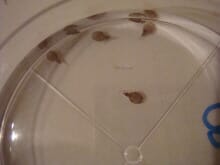Fish farmers are only too aware that they cannot allow sea lice to reach significant numbers without encountering significant problems. The consequences of sea lice infestations can be extremely severe, damaging delicate skin tissues with secondary bacterial infections and the subsequent loss of control over their internal environment. They can also affect fish appetite, SGR and FCR and can even act as disease vectors.

Extremely relevant and current is the effect of sea lice infestations, appearing to increase the susceptibility of fish to any disease agents that might be present eg ISA viruses.
We also need to remember that there may be unseen and damaging effects of sea lice such as those on delicate gill filaments when the early stages of sea lice attach moulting through a series of stages to free mobile stages. During these attached phases, sea lice will graze on gill lamellae and depending on number of lice involved can cause significant loss of blood through gill filaments.
So what constitutes effective sea lice control?
Regular weekly monitoring of sea lice numbers and life stages will allow informed decision making in advance of a serious infestation.Availability and application of effective treatments, this is where data on life stages of lice present will also inform which treatment to use.
Currently there is a range of potentially effective sea lice treatments available applied using immersion or in-feed route of application. The active ingredients in these treatments act to kill sea lice in significantly different ways.
If medicines are used in a strategic rotation rather than exclusively, as has been the case with some treatments in recent years, then they should enjoy a long and effective working life. All currently available sea lice medicines have their part to play and the decision which to use should be based on a number of considerations including:
- Expected efficacy of treatment
- Ease of application
- Health status of fish
- The actual cost of treatment, not just in actual medicine cost but also including any other additional costs such as mixing, if an in-feed, and labour if an immersion treatment. Days lost feeding and therefore potential lost growth must also be taken into account.
Only when all these factors have been considered should a final decision be made.
The investigation of potential reasons for any treatment failures.Once all the obvious reasons for treatment failures have been excluded and these can be numerous eg ineffective medicine concentration because of poor feeding response, mistakes in dosage calculation etc. then one of the most important areas left to consider is that of the susceptibility of the sea lice under treatment to the drug being used.
This is where the sea lice bioassay can be a very useful tool using lice taken off fish from the site under investigation.
When the medicine being used is a bath treatment at a known concentration, for a known duration and at a known temperature, the bioassay method can, under laboratory conditions, effectively replicate exactly what happens in the field,
Bioassays can also be used where the efficacy of in-feed treatments is being investigated. Whilst not exactly mirroring what happens in the field, bioassays are still a very useful tool. Bioassays involving in-feed medicines can still provide invaluable data. They can, in my opinion and experience, through longditudinal assays, ie regularly over a cycle and between different cycles, indicate strong trends in differences in sea lice susceptibility.
In conclusion, rather than employing sea lice bioassays when concerns are raised downline about any lack of efficacy they should be used at regular intervals throughout the whole growing cycle. The application of this simple test would alert fish farmers to any early indications of emerging resistance thereby allowing them to re-consider their treatment options.
Further articles will explore more fully other reasons for treatment “failures”.


